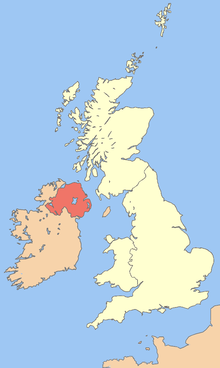Referendum in Northern Ireland in 1998
On 22 May 1998 was a referendum in Northern Ireland on the acceptance of the results of the so-called Good Friday Agreement ( Good Friday Agreement ) held. With an unusually high turnout, a clear majority of voters voted in favor of the agreement.
background
Since the partition of Ireland in 1920 by the Government of Ireland Act in Southern Ireland (later the Republic of Ireland ) and Northern Ireland, which remained with the United Kingdom , the latter had remained a trouble spot. While the Republic of Ireland laid down the requirement to reunify Ireland in its constitution, Northern Ireland's policy was unionist through and through the Protestant community theremajority minded population dominates. The Catholic minority was systematically discriminated against. In the late 1960s, there was ongoing unrest in Northern Ireland which resulted in the British Army being sent to Northern Ireland. In 1972 the Protestant Unionist-dominated Parliament and the regional government of Northern Ireland were finally suspended and Northern Ireland placed directly under the control of the London government. On March 8, 1973, a referendum was held on the nationality of Northern Ireland . In the referendum, a majority of voters decided to remain in the UK. However, the vast majority of Catholics had boycotted the vote.
Thereafter, the self-government of Northern Ireland was reorganized and the Sunningdale Agreement agreed on a division of political power between unionists and Irish nationalists. Extremist groups, however, did not recognize this agreement, so that terrorist acts continued.
After lengthy negotiations between the governments in London and Dublin, the so-called Good Friday Agreement was signed on April 10, 1998 with the aim of bringing about lasting peace in Northern Ireland. The key points of the agreement were the disarming of the paramilitary forces on both sides, the increased cooperation between the authorities of North and South Ireland, the removal of the requirement of reunification from the constitution of the Republic of Ireland and the readiness of London to accept reunification of Ireland if so the majority will of the population would be. The agreement made it a condition that both the people of Northern Ireland and the people of the Republic of Ireland would have to agree to it in separate referendums.
Almost all political groups in Northern Ireland recommended that voters accept the referendum. Supporters included the Ulster Unionist Party , the Social Democratic and Labor Party , Sinn Féin , the Alliance Party of Northern Ireland , the Progressive Unionist Party and the Ulster Democratic Party . The Democratic Unionist Party was negative .
The referendum
Both referenda - in Northern Ireland and the Republic of Ireland - took place on the same day. The question put to the voters in Northern Ireland was:
"Do you support the agreement reached in the multi-party talks on Northern Ireland and set out in Command Paper 3883?"
"Do you agree with the agreement reached in the multi-party talks on Northern Ireland, as set out in Outcome Paper 3883 [the Good Friday Agreement]?"
As a result, a clear majority of those who voted voted “Yes”:
| proposals | agree completely |
Percentage of votes | |
|---|---|---|---|
| of valid votes | of all eligible voters | ||
| Yes | 676.966 | 71.1% | 57.6% |
| No | 274,879 | 28.9% | 23.4% |
| Invalid votes | 1,738 | - | 0.1% |
The turnout was 81.1%, which is unusually high for an election in Northern Ireland. It is estimated that around 147,000 more voters were mobilized than in other elections. In the neighboring Republic of Ireland, the similar referendum question was even supported by 94.4% of the population, albeit with a lower turnout. In Northern Ireland no individual constituency results were deliberately announced in order to avoid drawing more detailed conclusions about the voting behavior of the population in Catholic and Protestant districts. It was estimated that up to 97% of Catholics or Irish nationalists and around 51 to 53% of Protestants or Unionists had voted “yes”.
consequences
Since both referendums were answered positively by the voters, the agreements of the Good Friday Agreement could be implemented. On June 25, 1998, the first election for the newly established Northern Ireland Assembly (Northern Ireland Assembly) took place. The Good Friday Agreement pacified Northern Ireland after decades of violence with hundreds of deaths on both sides. In a review by the BBC, 15 years after the agreement, both sides rated the agreements reached at that time largely positive.
Web links
- The 1998 Referendums , Northern Ireland Elections website
- Results of the Referenda in Northern Ireland and Republic of Ireland, Friday 22 May 1998 , CAIN Web Service
Individual evidence
- ↑ 1998 Northern Ireland Referendum - Summary of Party Positions and Campaign Leaflets. CAIN Web Service, accessed September 14, 2014 .
- ↑ a b c The 1998 referendums. Elections in Nortehrn Ireland, Nicholas Whyte website, accessed September 14, 2014 .
- ↑ a b c Results of the Referenda in Northern Ireland and Republic of Ireland, Friday 22 May 1998. CAIN Web Service, accessed on September 14, 2014 (English).
- ^ Martina Purdy: Good Friday referendum: Nationalists and Alliance reflect. BBC News, May 23, 2013, accessed September 14, 2014 .
- ↑ Martina Purdy: Good Friday Agreement referendum: Unionists reflect 15 years on. BBC News, May 22, 2013, accessed September 14, 2014 .
